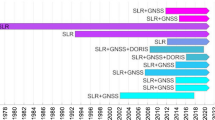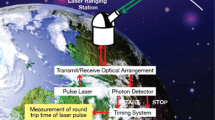Abstract
Laser ranging to Starlette from April 1983 to April 1984 has been used to determine a coordinate set, UASC.ST1, of laser reference points for 18 tracking stations. The coordinates were derived by application of the least-squares data reduction procedure in a simultaneous solution along with geodynamic parameters for 49 near consecutive 5–6 day arcs. Comparisons with the University of Texas station coordinates,LSC 8112 andLSC 8402, and theRGO, Herstmonceux, coordinates,RGOSC.LG2, reveal consistency to near 30 cm in each coordinate. Furthermore, the translation vectors of the comparisons are not significantly different from zero indicating consistency in the implied origins of the systems.
The period of analysis included seven occasions in which STARLETTE was tracked near simultaneously by three or four laser stations in North America. Using the short arcs as reference frameworks, station coordinates were determined by application of two contrasting methods, namely, a multi-arc simultaneous analysis and a weighted mean of the individual pass solutions. The former compared more favourably with baselines from the long-arc solution with anRMS error of near 16 cm. Comparison against theLSC 8402 coordinates confirmed that baselines accurate to within 15 cm can be achieved by satellite laser ranging to Starlette.
Similar content being viewed by others
References and Recommended Reading
Sorensen TI, Nielsen GG, Andersen PK, Teasdale TW: Genetic and environmental influences on premature death in adult adoptees. N Engl J Med 1988, 318:727–732.
Rietschel ET, Westphal O: Endotoxin: historical perspectives. In Endotoxin in Health and Disease. Edited by Brade H, Opal SM, Vogel SN, Morrison DC. Basel: Marcel Dekker, Inc.; 1999:1–30.
Heppner G, Weiss DW: High susceptibility of strain A mice to endotoxin and endotoxin-red blood cell mixtures. J Bacteriol 1965, 90:696–703.
Watson J, Kelly K, Largen M, Taylor BA: The genetic mapping of a defective LPS response gene in C3H/HeJ mice. J Immunol 1978, 120:422–424.
Coutinho A, Meo T: Genetic basis for unresponsiveness to lipopolysaccharide in C57BL/10Cr mice. Immunogenetics 1978, 7:17–24.
O’Brien AD, Rosenstreich DL, Scher I, et al.: Genetic control of susceptibility to Salmonella typhimurium in mice: role of the LPS gene. J Immunol 1980, 124:20–24.
Michalek SM, Moore RN, McGhee JR, et al.: The primary role of lymphoreticular cells in the mediation of host responses to bacterial endotoxin. J Infect Dis 1980, 141:55–63.
Freudenberg MA, Keppler D, Galanos C: Requirement for lipopolysaccharide-responsive macrophages in galactosamine- induced sensitization to endotoxin. Infect Immun 1986, 51:891–895.
Beutler B, Milsark IW, Cerami A: Passive immunization against cachectin/tumor necrosis factor (TNF) protects mice from the lethal effect of endotoxin. Science 1985, 229:869–871.
Tracey KJ, Beutler B, Lowry SF, et al.: Shock and tissue injury induced by recombinant human cachectin. Science 1986, 234:470–474.
Beutler B, Krochin N, Milsark IW, et al.: Control of cachectin (tumor necrosis factor) synthesis: mechanisms of endotoxin resistance. Science 1986, 232:977–980.
Wright SD, Ramos RA, Tobias PS, et al.: CD14, a receptor for complexes of lipopolysaccharide (LPS) and LPS binding protein. Science 1990, 249:1431–1433.
Haziot A, Ferrero E, Kontgen F, et al.: Resistance to endotoxin shock and reduced dissemination of gram-negative bacteria in CD14-deficient mice. Immunity 1996, 4:407–414.
Tobias PS, Soldau K, Ulevitch RJ: Isolation of a lipopolysaccharide- binding acute phase reactant from rabbit serum. J Exp Med 1986, 164:777–793.
Poltorak A, Smirnova I, He XL, et al.: Genetic and physical mapping of the Lps locus- identification of the toll-4 receptor as a candidate gene in the critical region. Blood Cell Mol Dis 1998, 24:340–355.
Poltorak A, He X, Smirnova I, et al.: Defective LPS signaling in C3H/HeJ and C57BL/10ScCr mice: mutations in Tlr4 gene. Science 1998, 282:2085–2088.
Poltorak A, Smirnova I, Clisch R, Beutler B: Limits of a deletion spanning Tlr4 in C57BL/10ScCr mice. J Endotoxin Res 2000, 6:51–56.
Lemaitre B, Nicolas E, Michaut L, et al.: The dorsoventral regulatory gene cassette spatzle/Toll/cactus controls the potent antifungal response in Drosophila adults. Cell 1996, 86:973–983.
Hoshino K, Takeuchi O, Kawai T, et al.: Cutting edge: Toll-like receptor 4 (TLR4)-deficient mice are hyporesponsive to lipopolysaccharide: evidence for TLR4 as the Lps gene product. J Immunol 1999, 162:3749–3752.
Takeuchi O, Hoshino K, Kawai T, et al.: Differential roles of TLR2 and TLR4 in recognition of Gram-negative and Gram-positive bacterial cell wall components. Immunity 1999, 11:443–451.
Werts C, Tapping RI, Mathison JC, et al.: Leptospiral lipopolysaccharide activates cells through a TLR2-dependent mechanism. Nat Immunol 2001, 2:346–352.
Hemmi H, Takeuchi O, Kawai T, et al.: A toll-like receptor recognizes bacterial DNA. Nature 2000, 408:740–745.
Hayashi F, Smith KD, Ozinsky A, et al.: The innate immune response to bacterial flagellin is mediated by Toll- like receptor 5. Nature 2001, 410:1099–1103.
Ozinsky A, Underhill DM, Fontenot JD, et al.: The repertoire for pattern recognition of pathogens by the innate immune system is defined by cooperation between toll-like receptors. Proc Natl Acad Sci U S A 2000, 97:13766–13771.
Muzio M, Ni J, Feng P, Dixit VM: IRAK (Pelle) family member IRAK-2 and MyD88 as proximal mediators of IL-1 signaling. Science 1997, 278:1612–1615.
Muzio M, Natoli G, Saccani S, et al.: The human toll signaling pathway: divergence of nuclear factor kappaB and JNK/SAPK activation upstream of tumor necrosis factor receptor-associated factor 6 (TRAF6). J Exp Med 1998, 187:2097–2101.
Kimbrell DA, Beutler B: The evolution and genetics of innate immunity. Nat Rev Genet 2001, 2:256–267.
Du X, Poltorak A, Wei Y, Beutler B: Three novel mammalian toll-like receptors: gene structure, expression, and evolution. Eur Cytokine Netw 2000, 11:362–371.
Chuang T-H, Ulevitch RJ: Cloning and characterization of a sub-family of human toll-like receptors: hTLR7, hTLR8, and hTLR9. Eur Cyto Netw 2000, 11:372–378.
Chuang T-H, Ulevitch RJ: Identification of hTLR10: a novel human Toll-like receptor preferentially expressed in immune cells. Biochim Biophys Acta 2001, 1518:157–161.
Smirnova I, Hamblin M, McBride C, et al.: Excess of rare amino acid polymorphisms in the Toll-like receptor 4 in humans. Genetics 2001, In press.
Arbour NC, Lorenz E, Schutte BC, et al.: TLR4 mutations are associated with endotoxin hyporesponsiveness in humans. Nat Genet 2000, 25:187–192.
Loppnow H, Brade H, Durrbaum I, et al.: IL-1 inductioncapacity of defined lipopolysaccharide partial structures. J Immunol 1989, 142:3229–3238.
Author information
Authors and Affiliations
Rights and permissions
About this article
Cite this article
Moore, P. Laser station coordinates and baselines from long-ARC and short-ARC analyses of starlette. Bull. Geodesique 60, 297–310 (1986). https://doi.org/10.1007/BF02522338
Received:
Accepted:
Published:
Issue Date:
DOI: https://doi.org/10.1007/BF02522338




